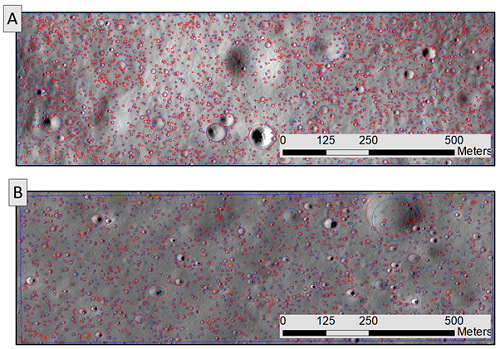High-resolution Automated Crater Detection of Small Lunar Craters on LRO-NAC Images
- 1School of Earth and Planetary Sciences, Curtin University, GPO Box U1987, Perth, WA, 6845, Australia
- 2CSIRO, Pawsey Supercomputing Centre, Kensington, WA, 6151, Australia
- 3Department of Earth and Planetary Sciences, Western Australia Museum, Locked Bag 49, Welsh-pool, WA 6986, Australia
- 4Planetary Science Institute, 1700 East Fort Lowell, Suite 106, Tucson AZ 85719-2395, USA
Introduction: The Moon’s bombarded surface acts as a 4 Ga cratering record due to the lack of any significant crustal renewal or erosional processes. This extensive record is analysed by studying the spatial densities of craters on the Moon’s surface across different geological landscapes. These differences in relative cratering densities are quantified and linked to radiometrically dated samples collected during the Apollo and Luna missions. Through all this, one can derive a model age of a cratered surface [1]. This technique is referred to as crater counting. Over the years, this technique has grown to be utilised in dating the surfaces of rocky bodies throughout the solar system [1]. The accuracy of this technique still lies in the ability to detect and measure impact craters. The availability of the Lunar Reconnaissance Orbiter (LRO) Narrow-Angle Camera (NAC) images, with a 0.5-2m/px resolution [2], allows us to see craters at the metre-scale. The leading lunar crater database, consisting of ~1.3 million manually counted craters, is complete down to 1km [3]. To utilise the high-resolution NAC imagery, we need to count ever-smaller craters. The number of smaller craters scale as a power law, meaning there are tens of millions of craters <1km [1]. Machine learning techniques bridges the gap, allowing us to quickly and accurately detect and measure millions of small craters. Our team has developed a Crater Counting Algorithm (CDA), based on a Convolutional Neural Network (CNN), that specialises in impact crater detection. Initially developed for Martian crater counting [4,5], the algorithm has now been adapted to analyse the Moon.
The Crater Counting Algorithm: The CDA is a CNN developed using You Only Look Once version 3 (YOLOv3), a pattern recognition algorithm, as its architecture. YOLO specialises in real-time single-pass object detection over an image, making it perfect for crater detection [6]. The CDA is run using a trained lunar detection model consisting of 25,973 manually marked craters across 188 tiled NAC images (416x416 pixel). These NAC images have incidence angles ranging from 65°-75° (afternoon/morning lighting), producing favourable shadows when identifying craters. The algorithm is run on a directory of input NAC images where it generates a detection output consisting of crater Long/Lat locations and a diameter.
NAC Image Preparation: The NAC images are downloaded in their raw IMG format, where they are georeferenced (a process of linking an images internal coordinate system to a geographical coordinate system) using the USGS’s Integrated Software for Imagers and Spectrometers (ISIS) [7]. ISIS ensures the NAC images have their correct lunar geometry. The images are then exported as GeoTiff files using GDAL, which are used as inputs for the CDA.
Model Evaluation: To evaluate the CDA’s ability in accurate small crater detection (D≤100m), the CDA analysed two ideal NAC images (one of each lunar terrain: highland and mare). Altogether, 4874 Craters within 750m2 subsections of each image, Mare Serenitatis (NAC: M1320016983LE) and Terra Sanitatis (NAC: M1338833866LE), were manually counted to validate against 3852 craters detected by the CDA (Fig. 1). The manual counting included all levels of crater degradation states with a ~5m cut off point. Most size categories boast high True Positive (TP) detection rates (>80%) (Tab. 1). True crater diameters across both terrains were mostly overestimated by the CDA (Tab. 1) but are still within the error margins (±20%) of human manual detections [8]. 18 ‘fresh craters’ (craters with clear and easily identifiable rims), with D≥25m, were chosen across both images (Tab. 1*). The CDA has excellent TP detection rates (100%) and diameter estimations (~±10%) for the fresh craters (Tab. 1*).
Prospects of the Lunar CDA: With further analysis and evaluation of the lunar CDA across broader lunar terrains, we want to create an accurate small crater lunar dataset. This dataset will fill the gap for craters <1km and can be used for fine-scale crater counting chronologies and geological interpretation. Once the process is fully streamlined, we will have the ability to accurately detect millions of small craters across 1000s of NAC images.

Figure 1: Visual comparison between CDA and manual detection over two 750m2 NAC subsections, manual detections are in red and CDA detections are in blue. Counting was completed across all levels of degradation. A) Highland terrain, Terra Sanitatis (NAC image M1338833866L at 1m/px resolution), counted crater diameter range: 5m-125m; B) Mare terrain, Mare Serenitatis (NAC image M1320016983L at 1m/px resolution), counted crater diameter range: 5m-137m.
Table 1: Confusion matrix of the manual (N=4874) and CDA (N=3852) detections over a 750m2 subsection. A) Highland terrain, Terra Sanitatis (NAC image M1338833866L at 1m/px resolution), counted crater diameter range: 5m-125m; B) Mare terrain, Mare Serenitatis (NAC image M1320016983L at 1m/px resolution), counted crater diameter range: 5m-137m. Note: ‘+’ average diameters indicated the CDA overestimated the true crater diameter, ‘-’ are underestimations.
References: [1] Neukum G., Ivanov B. and Hartmann, W.K. (2001). Chronology and Evolution of Mars, Kluwer. 96, 55–86. https://doi.org/10.1023/A:1011989004263. [2] Robinson, M.S., et al. (2010). Sp. Sci. Rev. 150, 81-124.[3] Robbins, S. J. (2019). Journal of Geophysical Research: Planets. 124, 871– 892. https://doi.org/10.1029/2018JE005592. [4] Lagain, A., et al. (2021). Earth and Space Science. https://doi.org/10.1029/2020EA001598. [5] Benedix, G.K., et al. (2020). Earth and Space Science. https://doi.org/10.1029/2019EA001005. [6] Redmon, J., Farhadi, A. (2018). arXiv :1804.02767. [7] https://isis.astrogeology.usgs.gov/. [8] Robbins, S.J., et al. (2014). Icarus. 234, 109–131. https://doi.org/10.1016/j.icarus.2014.02.022 .
How to cite: Fairweather, J., Lagain, A., Servis, K., Benedix, G., and Bland, P.: High-resolution Automated Crater Detection of Small Lunar Craters on LRO-NAC Images, European Planetary Science Congress 2021, online, 13–24 Sep 2021, EPSC2021-460, https://doi.org/10.5194/epsc2021-460, 2021.

